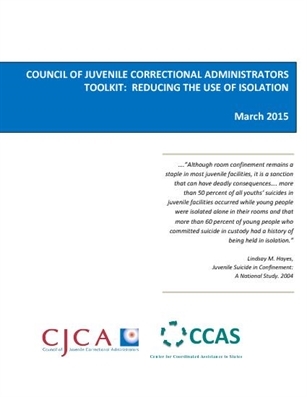Council of Juvenile Correctional Administrators Toolkit: Reducing the Use of Isolation
Published Mar 30, 2015, Council of Juvenile Correctional Administrators
Download
(1743 KB)

A response to behavioral problems in many facilities has been reliance on isolation for acting out youths who are mentally challenged, chronically violent, or gang involved. Instead of being used as a last resort to protect youths from self-harm, hurting others or causing significant property damage that is terminated as soon as a youth regains control, isolation too often becomes the behavior management system by default. Research has made clear that isolating youths for long periods of time or as a consequence for negative behavior undermines the rehabilitative goals of youth corrections. Agencies and facilities across the country are looking for help to change practices to align with the research and promote positive youth development. Many agencies have made sustainable reforms eliminating and reducing the use of isolation; at least 10 states have banned punitive solitary confinement. However others see increasing use of isolation and face significant barriers and resistance to changing the practice.
CJCA presents this toolkit to help its members and the field reduce the use of isolation and ultimately better help youths in juvenile facilities become successful members of the community.
The CJCA Toolkit provides:
- An overview of the issue of isolation and how it is defined;
- A summary of the research substantiating the negative impacts of isolation;
- Five steps to reducing the use of isolation:
- Adopt a mission statement and philosophy that reflects rehabilitative goals.
- Develop policies and procedures for use and monitoring of isolation.
- Identify data to manage, monitor and be accountable for use of isolation.
- Develop alternative behavior management options and responses.
- Train and develop staff in agency mission, values, standards, goals, policies and procedures.
- Action steps for CJCA directors; and,
- Case studies from four state agencies that significantly reduced the use of isolation.